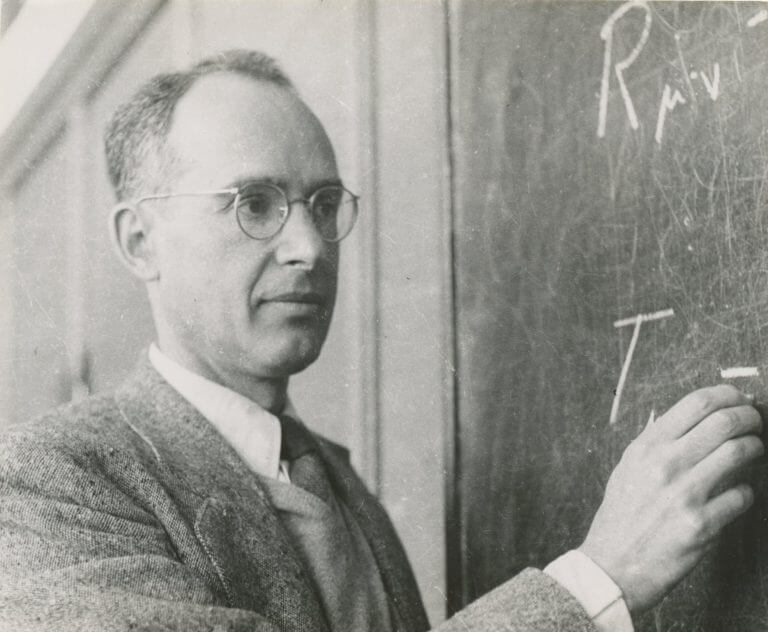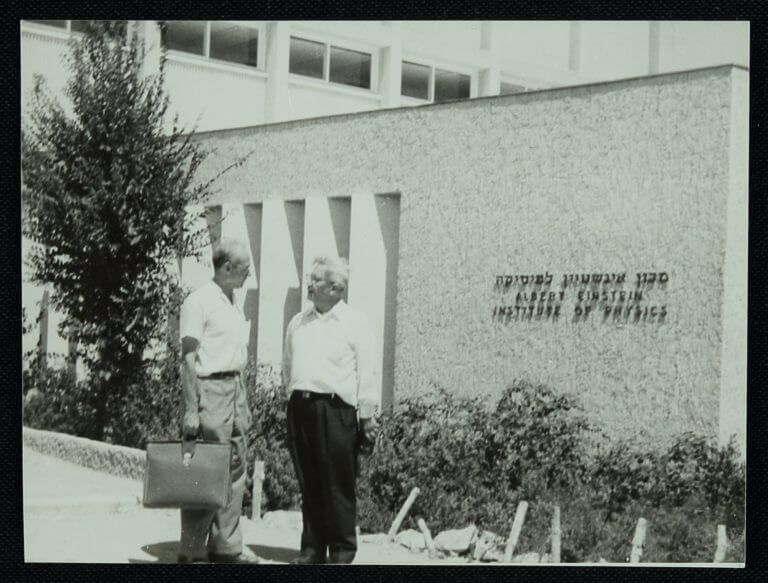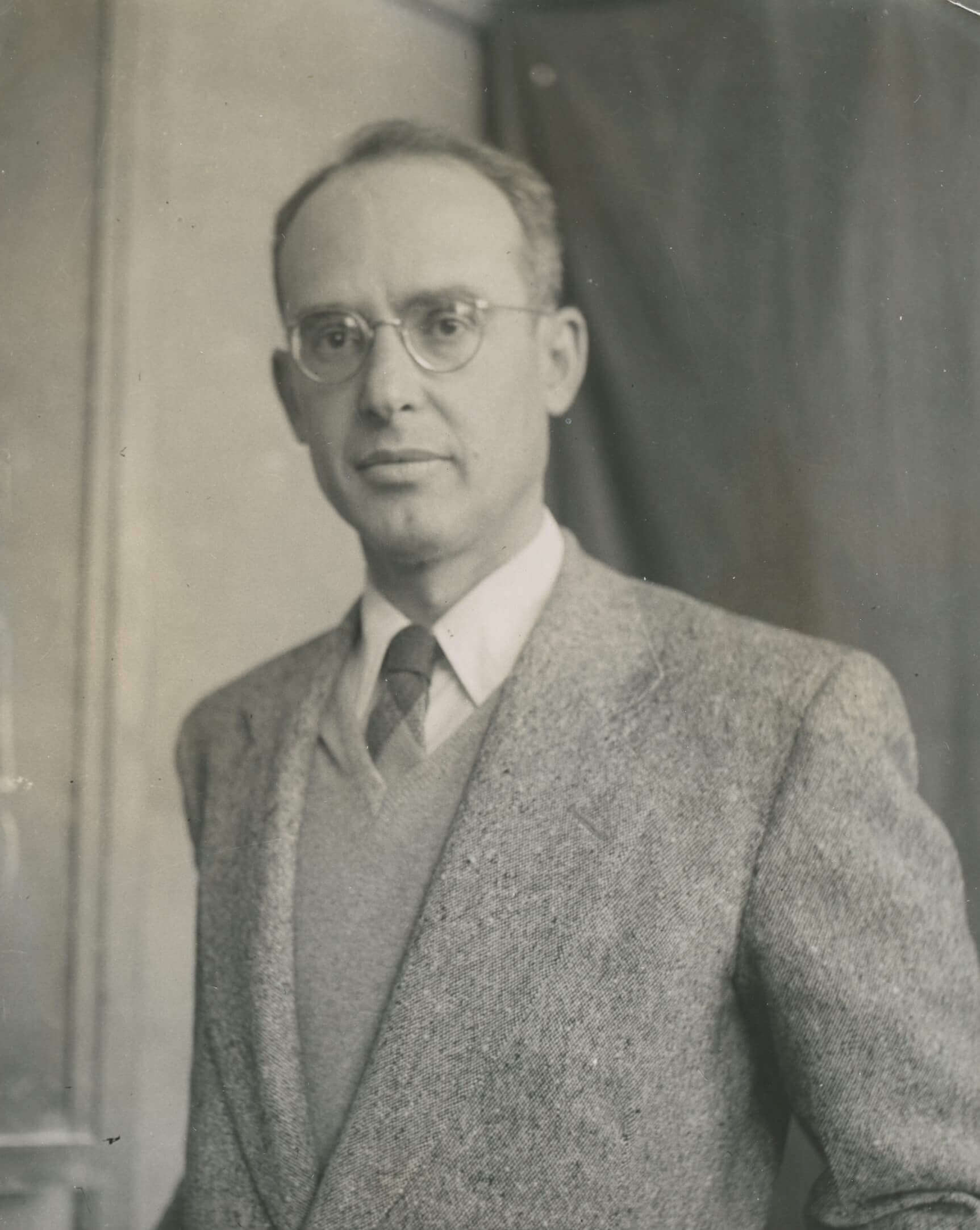Founder of the Faculty of Physics at the Technion, co-author of the historical article EPR with Albert Einstein and Boris Podolsky

Research Prof. Natan Rosen, founder of the Physics Faculty at the Technion, came to Israel after an impressive scientific career. Already at the age of 22, Rosen published two important articles, one of which predicted the existence of the neutron particle and the other presented a calculation of a model of the hydrogen molecule. Only four years later, at the age of 26, he published EPR together with Albert Einstein and Boris Podolsky, one of the most cited articles in the history of science. Einstein and Rosen later developed the concept that is now known as the "Einstein-Rosen Bridge" or in popular and cinematic language "Wormhole". The basic idea: a significant curvature of space-time can allow a transition between two points that are infinitely far from each other.
The historical article, published on May 15, 1935 and nicknamed EPR after its three authors (Einstein–Podolsky–Rosen), dealt with what the three perceived as a shortcoming of quantum physics. On its title - "Can a quantum-mechanical description of physical reality be considered complete?" - They answered in the negative.
One of the claims in the article was that according to quantum physics, manipulation of one particle will at the same time affect another particle that is at a great distance from it, without physical interaction and without the transfer of information; Therefore, Einstein claimed, it is a "spooky action at a distance" (spooky action at a distance). Einstein called the answer of Niels Bohr, who was awarded the Nobel Prize for his contributions to quantum mechanics, "Talmudic nonsense".
Three decades later, in 1962, the Irish physicist John Bell showed that the Einstein-Bohr controversy could be resolved experimentally, and the experiments conducted in the following years showed that "action at a distance" does occur in entangled particles.
According to Prof. Emeritus Yossi Ebron, former Dean of the Faculty of Physics at the Technion, "The EPR paradox led to a deeper insight into the revolutionary nature of quantum mechanics. Einstein asked for a theory that would describe a physical reality that is not conditioned by the intervention of the observer. This is the case in classical physics, where measurement reveals an existing reality: America existed even before Columbus discovered it. In the quantum world, on the other hand, the intervention of the observer affects the state of the system and therefore does not revealing Reality exists but Produces A new reality. Einstein expressed his displeasure graphically when he said to his friend and biographer, Abraham Pace: Do you really believe that the moon only exists when you look at it?
Einstein also disliked the fact that the randomness in quantum mechanics was not the result of a lack of information, and he expressed this by claiming that God does not play dice.

Natan Rosen was born in Brooklyn on March 22, 1909, two years after his parents fled pogrom-stricken Russia. When he was 11 years old, his father died and the family moved to Boston. At the age of only 25, with a doctorate in his pocket, he began working at Princeton, where he hoped to meet the famous Albert Einstein. Later, in an interview with "Maariv" (March 5, 1954), he said that "Like any scientist, it was my dream to meet, even if only for a few minutes, with Einstein. Even though I worked with him at one institution [Princeton], I postponed the meeting day by day, until I got the hang of it and entered his room. He received me with cordial kindness as if we were old acquaintances. The next day he met me in the university yard and he said to me: 'Young man, would you agree to work with me?' I was like a happy shock, and I don't know to this day what was my right to please him."
The reality, then, was more generous than the modest dream, and Dr. Rosen was Einstein's assistant at the Institute for Advanced Studies in Princeton, where he also matured the EPR paper.
With Einstein's encouragement, Rosen accepted a position at the University of Kyiv, from where he wrote to his teacher Varbo: "Here I feel that I am needed, that I am important, and to earn my living I do not need the support of small people in senior positions." Joe, the eldest son of Nathan and Hannah, was born in Kiev in 1937. Two years later, the second son, David, was born.
In a short time Rosen realized that his dreams of the Soviet world were shattered on the rocks of reality. He felt very well the limitations imposed by the regime on thought. "[There] everyone was interested in Einstein's theories, but then someone came and claimed that this theory was against dialectical materialism, and then the atmosphere started to get a little tense." Following this, and after many of his colleagues in Kiev were arrested by the communist regime, he returned to the United States and worked at MIT and the University of North Carolina.
In 1953, Prof. Rosen responded to the call of the Technion's president at the time, Colonel (Res.) Ya'akov Dori, and immigrated to Israel to join the Technion faculty. Here he played a central role in the transformation of the Technion from a "technical school" into a world-renowned scientific and technological institution. He was dean of the graduate school, dean of the science faculty, head of the physics department (later faculty) and head of the nuclear engineering department. In 1977 he was appointed research professor at the Technion - the highest academic rank.

Prof. Rosen also contributed a lot outside the Technion circle. He was one of the founders of the National Academy of Sciences, the Israel Physics Society and the International Society for General Relativity and Gravitation. To assist in the development of Ben Gurion University, he spent a period there as Dean of the Faculty of Engineering in 1971-1969.
At the Technion, he mentored many students, including Prof. Asher Peres, also one of the pillars of the physics faculty. Prof. Rosen won many awards, including the Weizmann Prize in Exact Sciences (1968), the Michael Landau Prize (1975) and an honorary doctorate from Ben Gurion University.
Natan Rosen passed away on December 18, 1995. His colleagues say that he worked until his last day. He maintained contact with Einstein for many years after immigrating to Israel, and in an interview with "Maariv" (March 5, 1954) he testified that Einstein told him that "I would gladly immigrate to Israel if I were not so old" and that "this Technion is something wonderful. And the State of Israel also has an extraordinary future, a great future!"
The photos are courtesy of the historical archive of the Technion by Yehoshua Nasiyo.

One response
I apologize in advance, because I'm not a physicist, I have a story that might be interesting. It is more related to the lines of the article "Einstein asked for a theory that would describe a physical reality that is not conditioned by the intervention of the observer. This is the case in classical physics, where measurement reveals an existing reality: America existed even before Columbus discovered it. In the quantum world, on the other hand, the intervention of the observer affects the state of the system and therefore does not reveal an existing reality but creates a new reality. Einstein expressed his displeasure pictorially when he said to his friend and biographer, Abraham Pace: Do you really believe that the moon only exists when you look at it?"
The story started from a point where I chose to be interested in the mechanism of longevity. A few years of research in science such as genetics, etc. and also ethnological studies in the field led me to try a behavioral direction based on religion. At some point I came to the experience that "the keys of life are in the hands of God" and if so it should be studied like any other educational material (studying or researching is the same thing). God immediately becomes an external reality for me and at the same time I noticed that it also becomes a concept expressing this reality that is in front of me. And I also noticed the application of an internal search to locate the new concept in the spiritual space (if this process can be described that way in terms of mental models). The internal search led to a direction from a vertical height above my right shoulder from behind, right next to the shoulder, so that in the view from this point I could see in the form of a cone spreading down and a front line descending in a slope to the front horizon and a second line perpendicular down passing through my back (spine) and in fact I saw myself inside the cone. I understood, this cone is the part of the universe that can be observed and investigated and the researcher's body is included in it, that is, it can also be investigated objectively. I just remembered EPR. By the way, another phenomenon that I noticed and which may not be directly related to quantum physics was discovered during a downward turn of attention, then the contours of objects were marked in a form closer to a sphere but not precise, like a cotton ball, and my first hypothesis was that it might be human beings. I continued to familiarize myself with the whole thing and turned my attention to a perpendicular line. At this moment, memories came from a school physics course about two positive and negative electrical resistors that can approach or repel, and this is precisely humans, and then I felt a perpendicular line as belonging to gravity (heavy?) and at the same time - editors belonging to all of humanity. At this moment it occurred to me that I am at one point and from there I can see both electromagnetic phenomena and mass force. All this happened in these days at the beginning of the month of Nissan 2006.
In a few years, in 2012, I happened to be exposed to an article about a French physicist Bernard d'Espagnat (one of Bohr's students?) who introduced a new concept and thereby solved one of the rather basic questions in quantum physics if I understood correctly according to popular articles. Even if I understood correctly, it is already from myself, being a physicist was a Christian, he tried to introduce a view into science and his concept is described by God as it is described by the human mind. And I understood the difference in his ways and mine. I let the mind act freely in the face of a new external reality and only recorded from the side. He introduced the content of a human researcher and thereby from the beginning limited the research and denied objective reality.